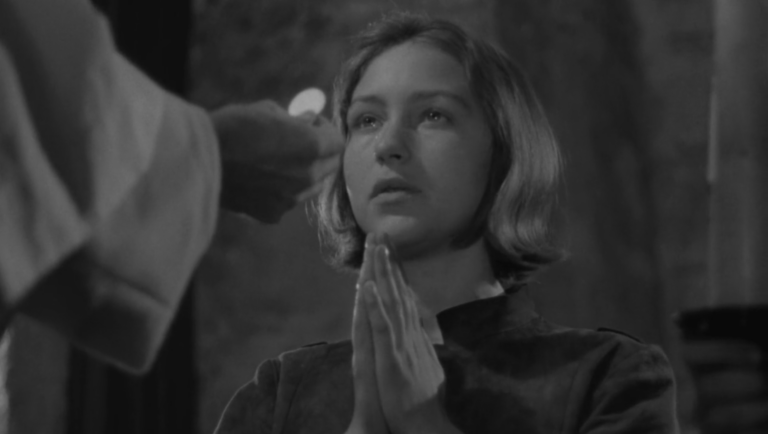Rushing through MUBI’s monthly dribble last year, I chanced upon Diary of a Country Priest. With the highest of praises that preceded Bresson, I decided to start the film. Five minutes passed, and I terminated the viewing. The landscape was more than a stone’s throw away from what I was accustomed to then; the dazzles of Almodóvar and rosemary-tinted windows of Wong Kar-Wai were the choices of that season. Looking back now, I see the benefits of viewing an oeuvre extensively before moving to another. Not merely for the tonal shift that I envisioned, but even for appraising the evolution of a director. Had I watched the film then, I would have been underwhelmed by its chilling frames and enervated characters. Having watched it now, cognizant of the departures to come in Bresson’s cinema, I was fixated with his rigour and more so the ornate liberties – which seldom, if ever, appear in his later works – he takes with each plunge of faith.
Films centred around plaintive internal anguishes are painful to execute; depending on the subject, at each turn or corner, the choice to remain artless or affix a discernable meaning to that turn is what distinguishes the film. So hard is this venture that the choice to err into the maudlin can pull your film back to earth at precisely the moment you wish for it to soar into the ineffable. Some like Bresson learned to drop crutches – theatricality and music being the major fatalities. Others, like Ozu and Kurosawa, adopted it when they needed it the most and in the right measure. In Ikiru, when Watanabe swings and softly lets his song sough the night, it brings the dimension of lost time in a way sight can’t. In Aparajito, Ray alternatively vacuums all sounds for the interplay of images to take place at the end. But they all managed to toe a fine balance – and it’s in those perfect offset of choices does a film leave behind the sentimental presses of theatre while partially embracing the piercing eyes of the camera. In his Diary of a Country Priest, he again produces such moments, and some leave an astounding effect when they employ little to no efforts to do so.
I’ve talked much at length about Bresson’s use of sound, but it was with Ambricourt and its drab moors that I asked myself about the quality of a frame in his works. In his parish, and even outside of it, the Priest of Ambricourt is shown with an accessible detachment; the shot is always either a stable close-up or a cautiously administered wide-shot, as when he staggers through the fields. The angles are always consistent and never shift to a dominant overview or a subservient low. The camera is rooted and moves only through pans and zooms. All these variances boxed together give the formulaic highs and lows of modish entertainment – a practice that Bresson was antithetic to. It’s this recurring feature of an image that marked itself as uniquely Bressonian over the years; starved of embellishments and existing only to penetrate what is sufficient and more importantly, what is primal.
Bresson’s history as a painter reflects the most in Diary of a Country Priest. Take the confessional scene for instance. Having received Chantal and hearing her fits of rage, he ushers her into the confessional and says that this is the only place where he is allowed to hear her. She snaps back with the rejoinder that she didn’t visit him to confess. Reluctantly, she moves into the darkened interiors of the stall. In the intercut that takes place, the Priest’s hortatory pleas belie the depleting strengths of his faith while she feeds onto his perplexed and limp assurances. The shadows that surround her have a mien of softness and engulf all but her convulsing face. It’s almost an extreme, monochromatic chiaroscuro that captures the mood of the entire film; the Priest is combating a steady loss of life and faith against a town – the one that Chantal fully represents – completely devoid of either.
The verbosity of the film, as opposed to its successors, is another un-Bressonian feature. There’s an outpouring of dialogue, between characters – notably, the interchange between the Countess and the Priest – and the Priest’s own soliloquy, which does not find a place in his later works. Could this film have done more with less? I’d think yes and no. There are instances – such as those between the rooted dogma of the village and the Priest – that could have benefitted from the treatment of a later Bresson, but largely, the loss of faith is never a quiet affair. The rancour of existential exile, as suffered by the Countess, needs the swordplay of words for one of two viewpoints to be defeated. The long, unfiltered conversation hinged on the weight of its pauses reminds me of the similar conversation between Aydin and Necla in Winter Sleep. Though the latter is much more protracted, they both justify their presence by giving a more definitive outcome that cannot be settled through mere gesticulation.
However, there’s a layer of allusion that Bresson would not interject in his future films; a fortified allusion, nonetheless more overt for someone of his nature. Here, there’s a good-bad angel complex shared between Seraphita and Chantal. The former, a young school girl, is at first a baleful sight for the Priest; he records in his journal that she torments him at every encounter. But when he staggers through the fields, and finally succumbs to the menace that is eating him from the inside, he wakes up to her empyrean face. Bresson does not show us this but lets us divine it from the words of the priest. When the scene is illuminated, she nurses his mud-stained face and walks him towards the road, with a radiant lamp in her hand that wards against the soft darkness. Placed directly in contrast with the confessional scene, it’s a layer of religious symbolism alien to Bresson. Tacky and unbecoming? It isn’t so and is rather appropriate for the film, but the explicitness of it is a degree higher than what you might be accustomed to with a more educated viewing of Bresson.
Like every other facet of this religious inquest that reappears in diminishing degrees across his later films, his employment of music is perhaps the most prominent. There’s much splicing that takes place with his soundtrack. Grunenwald’s pieces are slid into the everyday turmoil that the Priest faces in Ambricourt. This frequent interruption of silence, either through the persistent voice-overs or through the score, all bind together to maintain what Bresson termed the hot-and-cold dynamic. His voice-overs and music, cold and piteous, in effect catalyse the film’s movement that is being pinned down by the lacklustre aura of the parish. When all these early painterly signs are viewed in unison, it’s evident that Bresson was discovering himself, or more so, the medium of cinema. He was borrowing from the established spheres of painting and music to form an amalgam through the film. But, even in the early days, he chose Laydu – an aspirant of theatre who was an alien to film – to be his priest. All these middling decisions for departing from the roots of theatre effectively fissure his oeuvre in half through Diary of a Country Priest. As one thinks it through, what could be more befitting of this fissure than the redolence of juvenile faith against a terrain so indigent in soil and existential succour?
With Bresson, I’ve scuttled across the middle years, lingered in his late ones, and laboured through – like a sun-blessed farmer – in the early. I’ve seen him form dalliances with some extremes, but for the most part, I’ve admired his tenacity in being able to realize what he professes. In this regard, Monsieur Bresson is a very fine gentleman; perhaps, amongst the finest in the world of cinema. I’m not yet done with his body of work, and I shall shortly be returning to The Trial of Joan of Arc. But I wish to extend to all who seek the resurgence of lost faith an invitation to the honest recollections of a browbeaten priest. In the face of his adversity, he is supple yet volatile – much like the last master of French cinema himself.





